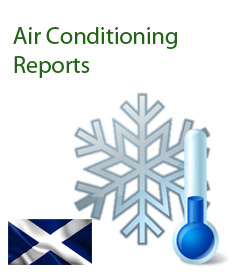Air Conditioning Inspections - Scotland
The requirement for the inspection of air conditioning systems in buildings was introduced under Article 9 of the original Directive 2002/91/EC. This, and the provision of advisory reports, is now required under Articles 15 & 16 of the recast Directive, 2010/31/EU.
Application
The requirement to have these systems inspected is implemented under regulation 17 of the Building (Scotland) Regulations 2004 and set out, with accompanying guidance, within Section 0 of the BSD Technical Handbooks.
The requirement for inspection of air-conditioning systems became mandatory from 1 May 2007 but was subject to phased introduction. All systems with an effective output of 250 kW or more were to be inspected by 4 January 2011, with all other systems with an effective output of 12 kW or more to have their first inspection completed by 4 January 2013.
All buildings with an air-conditioning system with an effective rating of 12 kW or more must now have received their first inspection. Failure to have your building systems inspected will leave you liable to an enforcement notice and action under section 26 of the Building (Scotland) Act 2003.
What is involved in an inspection?
Inspection covers the assessment of the efficiency and sizing of the system compared to the cooling requirements of the building and provision of advice to the building owner. The purpose of the inspection is to promote the efficiency operation of such systems and improve the energy efficiency of the building.
Findings are recorded in an inspection report which may also include measures which could be undertaken to improve the energy efficiency of the building to reduce cooling load. The report also sets the timescale for the next inspection (3-5 years), subject to the current efficiency of the system.
Guidance on the inspection and reporting process is set out in CIBSE document TM44 . http://www.cibse.org/index.cfm?go=news.view&item=178. Please note that, in Scotland, in assessing whether a building is subject to this legislation, individual systems each of 12 kW or less, but together totalling 12 kW or more only require inspection if they are linked by way of a central control.
Who can carry out the inspection?
Inspections may only be carry out a by a member of an organisation with whom Scottish Government have entered into a protocol agreement. These organisations, who publish lists of registered members, are listed on our website at http://www.scotland.gov.uk/Topics/Built- Environment/Building/Building-standards/enerperfor/inspectaircon.
Common Questions
How do I know if my system is more than 12kW?
The following guidelines provide an indication on areas likely to require 12 kW of cooling. If you are uncertain – seek specialist advice.
-
200 m2 floor area of air-conditioned general office
-
100 m2 floor area of air-conditioned office with high levels of IT/electrical equipment
-
250 m2 flour area of retail spaces with average display lighting levels
-
150 m2 floor area of retail spaces with high levels of display lighting and illuminated cabinets
I have several cooling units in my building – each less than 12kW. What should I do?
An inspection would be required if the individual units or systems taken together total more than 12kW and if they are:
-
within one building or dire seperated part of a building; and
-
are linked by a central conrol
When does the inspection have to take place?
A timetable for inspection requirements was set out in May 2009. All systems with an effective rated output of more than 12 kW had to be inspected by 4 January 2013. The inspection report provided by the assessor will show when the next inspection is due, usually a period of 3-5 years depending on the efficiency of the system. Information on requirements for inspection is provided under regulation 17 of the building regulations within section 0 of the BSD Technical Handbooks.
What will the assessor look for?
The assessor will inspect the system to provide basic information on the energy efficiency of the system and provide a report which includes recommendations for cost-effective improvements which can be made to the system.
What information will be shown on the inspection report?
The report will include details of:
-
the equipment inspected
-
the inspection of documents and records
-
inspection of the system documentation
-
inspection of the outdoor and indoor units
-
inspection of the system controls
-
summary of advice
-
general observations and advice for load reduction or alternatives
-
when the next inspection should be carried out.
Do I have to carry out improvements based on the recommendations?
No – this is not a legal requirement but action would improve the efficiency of the system and may reduce operational costs.
Can the inspection be combined with any other inspection?
Yes. This inspection will only cover energy efficiency issues, but could be carried out with other statutory inspections and routine maintenance as appropriate.
What should I do with the inspection report?
We recommend that this is kept in a safe place perhaps alongside the services log book which can be made available to future tenants, owners or inspectors.






